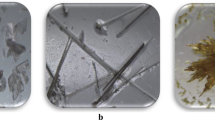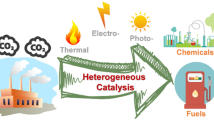Abstract
In order to obtain a better understanding of the pyrolysis mechanism of urazole, molecular orbital (MO) calculations and evolved gas analysis were carried out. The MO calculations were performed using the density functional method (B3LYP) at the 6-311++G(d,p) levels by Gaussian 03. The geometrical structure of urazole and its tautomers were examined theoretically. Identification and real-time analysis of the gases evolved from urazole were carried out with thermogravimetry-infrared spectroscopy (TG-IR) and thermogravimetry-mass spectrometry (TG-MS). The evolved gases were identified as HNCO, N2, NH3, CO2, and N2O at 400 °C, but were different at other temperatures.






Similar content being viewed by others
References
Sinditskii VP, Smirnov SP, Egorshev VY. Thermal decomposition of NTO: an explanation of the high activation energy. Propell Explos Pyrotech. 2007;32:277–87.
Thangadurai S, Karatha KPS, Sharma DR, Shukla SK. Review of some newly synthesized high energetic materials. Sci Tech Energ Mater. 2004;65:215–26.
Hara Y, Taniguchi H, Ikeda Y, Takayama S, Nakamura H. The thermal decomposition and hazards evaluation for 3-nitro-1, 2, 4-triazol-5-one. Sci Tech Energ Mater. 1994;55:183–7.
Rothgery EF, Audette DE, Wedlich RC, Csejka DA. Preparation, crystal structure, thermal decomposition mechanism, and thermodynamical properties of H[Pr(NTO)4(H2O)4]·2H2O. Thermochim Acta. 1991;185:19–25.
Badea M, Olar R, Marinescu D, Basile G. Thermal behavior of some new triazole derivative complexes. J Therm Anal Calorim. 2008;92:209–14.
Li N, Chen SP, Gao SL. Crystal structure and thermal analysis of diaquadi (1, 2, 4-triazol-5-one)zinc(II) ion nitrate. J Therm Anal Calorim. 2007;89:583–8.
Arai M, Tsukahara T, Ueda Y, Ichikawa K, Tamura M. Proceedings of 23th international pyrotechnics seminar, Tsukuba, September 30–October 4, 1997, p. 53–63.
Arai M, Tsukahara T, Tamura M. Proceedings of 26th international pyrotechnics seminar, Nanjing, October 1–4, 1999, p. 7–14.
Fischer G, Geith J, Klapotke TM, Krumm B. Synthesis, properties and dimerization study of isocyanic acid. Z Naturforschung. 2002;57b:19–24.
Frisch MJ, Trucks GW, Schlegel HB, Scuseria GE, Robb MA, Cheeseman JR et al. Gaussian 03 revision E 01. Wallingford CT: Gaussian Inc.; 2004.
Jensen JO. Vibrational frequencies and structural determinations of urazole. Spectrochim Acta A. 2003;59:637–50.
Gordon PG, Audrieth LF. Hydrazine derivatives of the carbonic and thiocarbonic acids. VI. A new synthesis of urazole. J Org Chem. 1955;20:603–5.
Author information
Authors and Affiliations
Corresponding author
Rights and permissions
About this article
Cite this article
Yoshino, S., Miyake, A. Pyrolysis mechanism of urazole by evolved gas analysis. J Therm Anal Calorim 99, 145–148 (2010). https://doi.org/10.1007/s10973-009-0571-9
Published:
Issue Date:
DOI: https://doi.org/10.1007/s10973-009-0571-9




